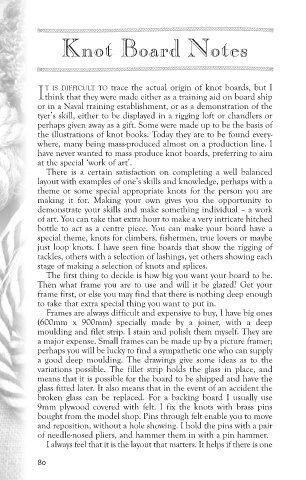Page 81 - Des Pawson "Des Pawson's Knot Craft" 2 edit.
P. 81
KNOTCRAFT 2009:Layout 1 23/10/09 12:17 Page 80
Knot Board Notes
T IS DIFFICULT TO trace the actual origin of knot boards, but I
Ithink that they were made either as a training aid on board ship
or in a Naval training establishment, or as a demonstration of the
tyer’s skill, either to be displayed in a rigging loft or chandlers or
perhaps given away as a gift. Some were made up to be the basis of
the illustrations of knot books. Today they are to be found every-
where, many being mass-produced almost on a production line. I
have never wanted to mass produce knot boards, preferring to aim
at the special ‘work of art’.
There is a certain satisfaction on completing a well balanced
layout with examples of one’s skills and knowledge, perhaps with a
theme or some special appropriate knots for the person you are
making it for. Making your own gives you the opportunity to
demonstrate your skills and make something individual – a work
of art. You can take that extra hour to make a very intricate hitched
bottle to act as a centre piece. You can make your board have a
special theme, knots for climbers, fishermen, true lovers or maybe
just loop knots. I have seen fine boards that show the rigging of
tackles, others with a selection of lashings, yet others showing each
stage of making a selection of knots and splices.
The first thing to decide is how big you want your board to be.
Then what frame you are to use and will it be glazed? Get your
frame first, or else you may find that there is nothing deep enough
to take that extra special thing you want to put in.
Frames are always difficult and expensive to buy, I have big ones
(600mm x 900mm) specially made by a joiner, with a deep
moulding and filet strip. I stain and polish them myself. They are
a major expense. Small frames can be made up by a picture framer;
perhaps you will be lucky to find a sympathetic one who can supply
a good deep moulding. The drawings give some ideas as to the
variations possible. The fillet strip holds the glass in place, and
means that it is possible for the board to be shipped and have the
glass fitted later. It also means that in the event of an accident the
broken glass can be replaced. For a backing board I usually use
9mm plywood covered with felt. I fix the knots with brass pins
bought from the model shop. Pins through felt enable you to move
and reposition, without a hole showing. I hold the pins with a pair
of needle-nosed pliers, and hammer them in with a pin hammer.
I always feel that it is the layout that matters. It helps if there is one
80

